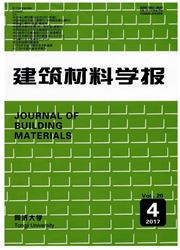

 中文摘要:
中文摘要:
采用计算机断层扫描成像(CT)技术、扫描电镜(SEM)、X射线能谱仪(EDS)、显微硬度(MH)等各种微细观测试手段对砂岩、锈染砂岩、锈面砂岩、板岩及大理岩骨料界面特性开展了试验研究,分析了以上几种骨料的界面特性对混凝土力学性能的影响机理.研究表明:不同骨料界面区微结构相差很大,不同骨料的化学成分和矿物组成影响了界面区水化产物的数量、形态、尺寸和生长发育特性;骨料的界面区显微硬度与界面区钙硅比有良好的对应关系,钙硅比越大则界面显微硬度越低;大理岩混凝土的起裂强度明显低于砂岩、板岩和锈染砂岩混凝土,且相同荷载条件下,大理岩混凝土的裂纹面积远高于其他骨料混凝土.
 英文摘要:
英文摘要:
The aggregate interface characteristics of sandstone, rust dye sandstone, surface rust sandstone, slate and marble were investigated by means of the computerized tomography(CT) technology, scanning electron microscope(SEM), energy dispersive spectromete(EDS) and microhardness(MH) and the mechanism of interface features of the above aggregates on mechanical properties of concrete were studied. It was shown that the microstructures of different aggregates interracial transition zone(ITZ) vary considerably. The chemical composition, mineral composition and surface texture of different aggregates affect the quan- tity, shape, size and growth characteristics of the hydrated product of ITZ. The microhardness is well related to the molar ratio of CaO to SiO2 (nc/ns) of the ITZ. The higher nc/ns, the lower microhardness. The initial cracking strength of marble aggregate concrete is significantly lower than those of sandstone, slate and rust dye sandstone aggregate concrete. In the same load condition, the cracking area ratio of marble aggregate concrete is far higher than other aggregate concrete.
 同期刊论文项目
同期刊论文项目
 同项目期刊论文
同项目期刊论文
 期刊信息
期刊信息
